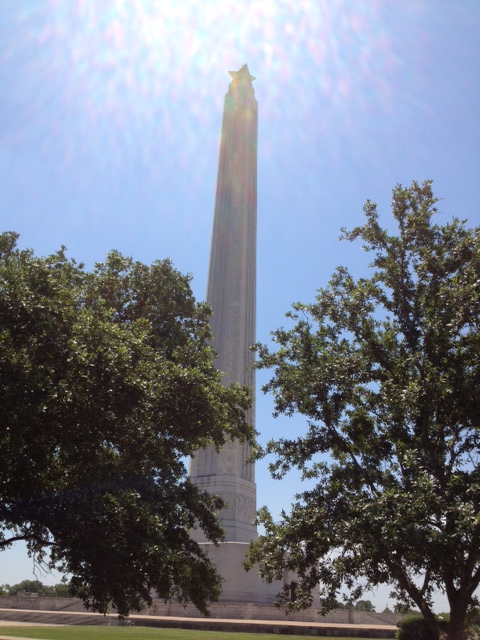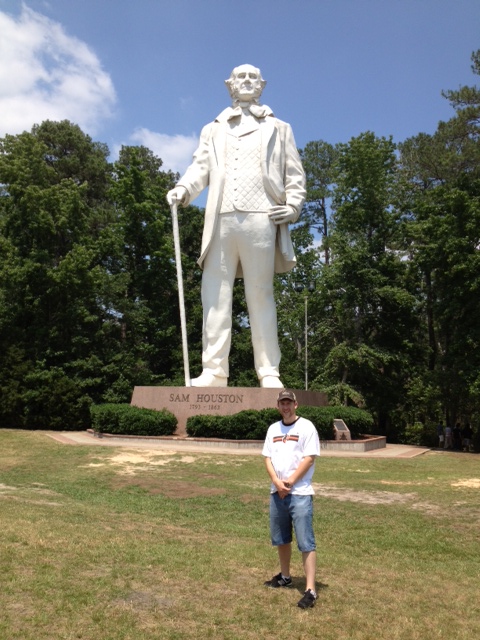A Little Southeast Texas History

The past weekend, my wife and I made a trip down to Houston to visit a good friend. Knowing that I was a history buff—or nerd (but I like the term “buff” better)—we made plans to head out to San Jacinto Battlefield and up to Huntsville, Texas, the final home of Sam Houston.
San Jacinto Battlefield State Park and Monument sits back behind a few oil refineries to the east of the city of Houston. It was here on April 21, 1836 that the Texan army, commanded by Sam Houston—an adopted Texan born in Virginia by way of Tennessee—surprised and routed the Mexican army under General Santa Anna de Lopez, gaining Texan independence. The monument is approximately 567 feet tall—taller than the Washington Monument in Washington D.C.—making it the tallest stone monument in the country. Which makes sense, because everything is bigger in Texas right?Sitting on top of the monument is a 220-ton star that commemorates the battle. Inside the monument is a museum, theatre, and access to the observation deck, which is 489-feet in the air!

Sam Houston, after defeating the Mexicans at San Jacinto, served both as president and multiple times as governor of Texas. He liked Huntsville, in particular, because the forests around the town reminded him of Tennessee, so he chose to take up residence there.
After playing an active role in Texan politics and history, he was serving again as governor during the early 1860’s and was a committed pro-Union advocate. When he refused to take the oath of allegiance to the Confederacy, he was excused from office, and Texas, which had voted to secede on February 1, 1861, joined the Confederacy on March 2, 1861.
The thought, while visiting the colossal statue of this great man, alongside Interstate-45, was the magnitude of that decision in 1861. His hard-worn prestige—born through his admirable service during the Texan Revolution, and later as a statesmen—all came to naught in 1861. What were his thoughts? Was it a feeling of loss, regret, shame, all three? He had fought to get Texas into the United States, and now his own statesmen had voted the state out.

Sam Houston died on July 26, 1863 at the age of 70 in Huntsville, Texas.
One man who had committed himself to the Confederacy and was assigned to Texas was General “Prince John” Magruder of Yorktown fame and Seven Days’ shame. Sent to command at Galveston, he earned the thanks of the Confederate government for retaking the city and port of Galveston from the Union in January 1863. The rest of the war saw him in command in different functions in the Trans-Mississippi until the region was surrendered by General Kirby-Smith in 1865.
Today this Confederate general and defender of Galveston lays in his final resting place a few blocks back from the Gulf of Mexico in Galveston’s Old City Cemetery.

The waterfront he defended is now filled with hotels and beachfront property. Maybe “Prince John” would have approved of the joviality—he seemed to relish a good production—that replaced the war and destruction in Galveston? One can only surmise.
So, between Revolution and Rebellion, southeastern Texas played an important part in American history. It’s definitely worth a visit—maybe in the spring, unless you like heat and humidity!
If planning a visit to Houston to visit these sites here are a few helpful websites:
San Jacinto Monument: http://sanjacinto-museum.org/
San Jacinto Battleground State Historic Site: http://www.tpwd.state.tx.us/state-parks/san-jacinto-battleground
Sam Houston Statue & Museum: http://www.huntsvilletexas.com/
Great post! Always loved the Texas Revolution. Future Confederate General Ben McCulloch fought at San Jacinto.
I visited the San Jacinto battlefield before I ever really got battlefield crazy, but I loved it. The shellstone that the monument is made of boggled my mind.
I appreciate your musings about Sam Houston. Bummer that he didn’t live to see his state come back into the Union.
How about the battle of Sabine Pass
My great great grandfather Man field was a Dr. at Dick Rowling